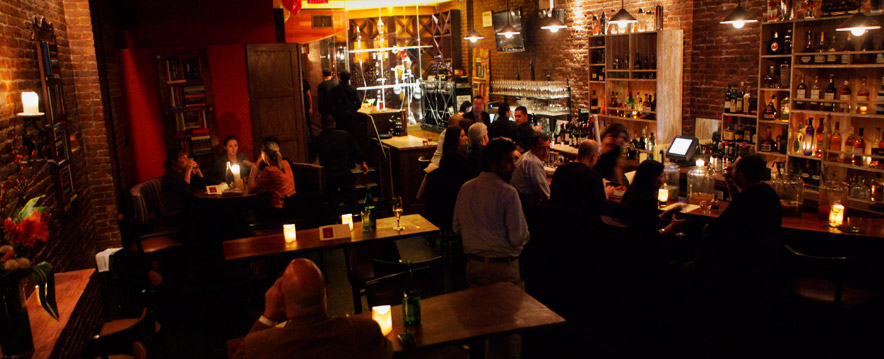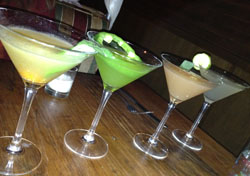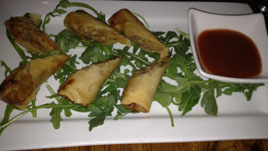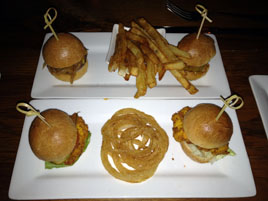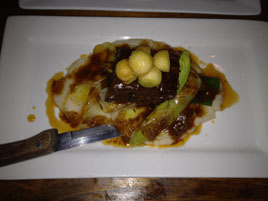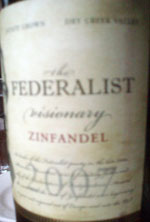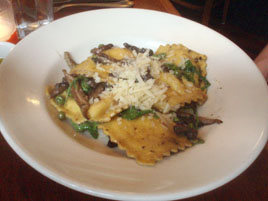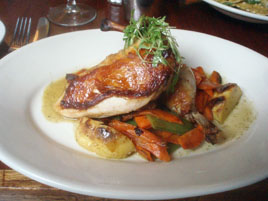Dovetail (remodeled)
 Monday, March 5, 2012 at 03:55PM
Monday, March 5, 2012 at 03:55PM  News that Dovetail had remodeled yet again brought me back last week, where I hadn’t been since a disastrous “Sunday Suppa” in 2008.
News that Dovetail had remodeled yet again brought me back last week, where I hadn’t been since a disastrous “Sunday Suppa” in 2008.
I’ve been a fan of chef John Fraser since he was at Compass. His short-lived pop-up, “What Happens When,” served one of the best meals I had in 2011. But neither of my Dovetail visits quite lived up to the three New York Times stars or the Michelin star it currently holds.
 The space was remodeled in 2009 (photos here, here), gaining a new 16-seat bar area, twenty new seats in the dining room, and an expanded wine cellar. But it still resembled the original décor (left), with exposed brick and no tablecloths.
The space was remodeled in 2009 (photos here, here), gaining a new 16-seat bar area, twenty new seats in the dining room, and an expanded wine cellar. But it still resembled the original décor (left), with exposed brick and no tablecloths.
Last month, Dovetail closed again for a week. This time, they’ve gone all-in for elegance: there are crisp white tablecloths, and no more brick. It finally looks like a three-star restaurant.
That makes Dovetail more endearing, though it would no doubt have been a demerit when Frank Bruni and Adam Platt reviewed it four years ago. Its reputation assured, Dovetail no longer hedges its bets.
The current menu is in four sections: appetizers ($20–34), vegetables ($17–34), entrées ($37–48), and desserts ($10–16), with about half-a-dozen choices per category. Yes, that’s expensive if ordered à la carte. There’s a four-course $85 prix fixe, but you can order just two courses (as we do in most restaurants, and did here), and contain the damage.
I can certainly do without such pompous moralizing, as: “The chef recommends that you order four courses.” Yeah, duh. Of course he does. If you offer a carte, don’t act disappointed when diners use it.


Dovetail has always served a trio of amuses bouches (above), and although I failed to take note of them, they were excellent—as they’ve always been.


From the vegetable section came a compelling starter: cured carrots, chicken feed (sic), and a soft-boiled egg ($18; above left). I wouldn’t serve it to a hungry football team, but it is larger than it appears in the photo.
Braised lamb ravioli with saffron, olives, and peppers ($24; above right) were also quite good, if a shade less novel.


Swordfish ($37; above left) with clam chowder, chorizo, and thyme, was the evening’s most impressive production, as beautifully cooked as it was to look at. (Fraser does have a high quotient of ingredients to the square inch.)
But it seems there is always one dud at Dovetail, and this time it was Sweetbreads ($46; above right) with heirloom potatoes, bacon, and truffles. It takes chutzpah to charge $46 for sweetbreads. They really have to be good. These were just average, and and the truffles didn’t add much flavor.
 The dining room was not very busy, but we dined relatively early on a Saturday evening, and then left for a show. Our upselling server did a fine job, once he was past trying to sell us into four courses.
The dining room was not very busy, but we dined relatively early on a Saturday evening, and then left for a show. Our upselling server did a fine job, once he was past trying to sell us into four courses.
The 24-page wine list has magnums of 1959 Château Latour at $11,000; yet, they’ll happily sell you a recent Beaujolais Nouveau at $30. The sommelier showed not a hint of dismay that I ordered it. The server could learn from her. That Beaujolais isn’t an anomaly, either. Whatever your price range, you can do business here.
In 2008, appetizers at Dovetail were $11–18, entrées $24–34. You could order at the bottom or the middle of that range, and walk out with an excellent mid-priced dinner. At its current, much higher prices, Dovetail can no longer claim to be an over-achieving neighborhood place. Fraser wants a second Michelin star.
At its best, Dovetail lives up to its billing. Fraser is a talented chef: the effort and craftsmanship in his best work elevate this restaurant over most of its peers. But at these prices, the duds (even if rare) are harder to excuse.
Dovetail (103 W. 77th Street at Columbus Avenue, Upper West Side)
Food: **½
Service: **½
Ambiance: ***
Overall: **½


